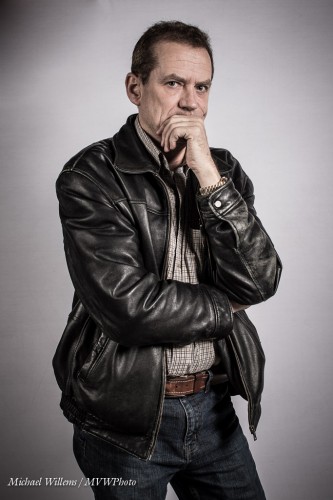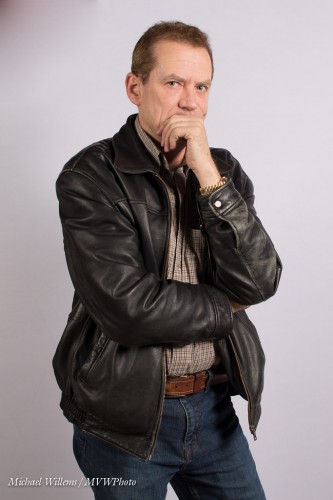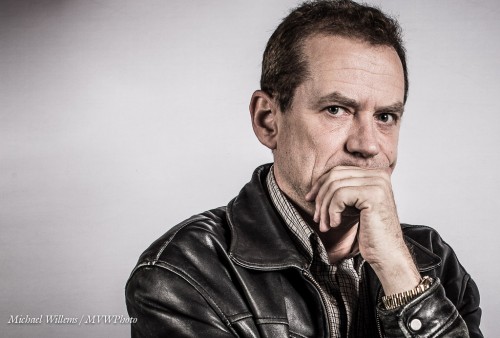There is a controversy over the image that won the World Press Photo award. The photographer did some desaturating: read about it here.
Personally, I think that in a press photo, changes are allowed only if they do not change the nature of the photo (i.e. cropping, exposure adjustment, white balance are OK), or if they bring back the image to what a person would have perceived. But when the adjustment is done to make a political point, as seems the case in the above example, I am against it. There is no well-defined line, so it is a tough call, but if I did that for a press photo, I would not work in press again.
However, in art, all is allowed. The question there is: is it OK to still call yourself a photographer, when you do such trickery?
Like this image from a few hours ago, showing, um, me:
The original, “actual” image, was this:
But then I added some Lightroom effects to desaturate the image, and increase the contrast. Cropped, it looks even better (can you tell, I rather like negative space, and the rule of thirds?):
View at original size to get the idea. Nice, no? And very fashionable. This desaturate thing, like HDR,is all the rage.
But if I do this, am I still a photographer?
On balance, I think so. If I do not overdo it, yes. If the original is still recognizable in the end product, yes. If I don’t do it every time, yes. If I do what can be done in camera, in the camera, yes. After all, photographers have always spent lots of time in the darkroom. Ansel Adams spent more time in the darkroom than in nature. And in the past, you would have chosen a film to give you the effect you wanted, and filters.
So I think that you can do dramatic post as long as:
- You do it well.
- You do not overdo it.
- You could not have done it in camera.
- It’s not journalism.
What do you think?




How about: You are not a photographer unless you shoot colour slide film and display the entire frame of the slide with a projector.
In a standard darkroom you can do all sorts of amazing editing tricks if you know how. Print lighter, darker, dodge, burn, change contrast, desaturate – all the way to B&W if you want, add a second image, change DOF, add a couple of people, remove someone …endless list. Photoshop just makes it easier because you can reverse a step without having to start over. It is faster, less messy and less expensive since you are not using paper and chemicals. The real difference is that as eight year old girls start photo editing on their iPhones, the notion that a photo can be edited is sinking into the consciousness of the general population.
If you shoot B&W, you can put coloured filters over the lens to affect the way colours register on the film, you can repeat that in the darkroom too, so you can make objects stand out or disappear.
Doing it in camera! Just pick the right camera! Digital cameras offer advanced panorama features, double exposures, HDR, red eye removal, a long list of editing features.
Journalism should be about integrity. Photojournalism should be too. But, integrity is achieved through representing a situation honestly. While that does not preclude using Photoshop to enhance an image, it may dictate where you point the camera before releasing the shutter.
Where did the idea that a photograph contained truth come from? The general population seems to hold that naive notion. Photo manipulation has been done almost as long as photography. Even with the relatively pure slide film, you could use Agfa, Fuji, Kodak and so on to get different effects, and you could do double and triple exposures. For a while last year you were gushing over your tilt-shift lens. That lens can be used to distort aspects of an image, but even choice of wide angle or telephoto introduces opportunity to distort reality. Even what you choose to show by standing back or getting close, or cropping, affects the integrity of the image.
That line you speak of, Michael, is not only not well-defined; it’s been through so many effects filters that it’s barely recognizable at times.
I might argue that the middle of the “blurry zone” is when the region select tools come out. Global adjustments- curves, levels, saturation, etc.- are, I would say, tools to convert what the machine saw into what the person saw. If the technical corrections necessary to convert an image from bayerized RGB on CMOS into halftone CMYK on newsprint are legit, then global adjustments to make some interim step of that process better reflect the photographer’s intent would be hard to argue against.
When you start dodging, burning and masking, though, I think you’ve left the realm of photojournalism. (Make that fire brighter and its smoke blacker, etc.) Local adjustments quickly move from “correcting a flaw in the capture process” to “changing the subject of the photo”. For art? Sure. For journalism? Nope.
True, though I’d argue that the middle zone is when the meaning is altered to further some kind of agenda. Which I migh feel is the case by desaturating that news image.
The Raw image is beautiful, the changes make it that much more touching. It helped him win, no matter what we think. Photography is always changing, it is great to discuss the changes. I do hope the RAW image is captured properly before lightroom/photoshop is applied but I know that is not reality, photoshop is the new artists’ paintbrush if known how to use to its fullest 🙂
True! But.. Is journalism art, or should it at least TRY to be true to life?